| View previous topic :: View next topic |
| Author |
Message |
Farside


Joined: 01 Sep 2007
Posts: 6557
Location: Ireland
Expire: 2013-12-27
|
 Posted: Sat Mar 21, 2009 12:43 am Post subject: Canon flash voltages Posted: Sat Mar 21, 2009 12:43 am Post subject: Canon flash voltages |
 |
|
Farside wrote:
From Tech Tips by Chuck Westfall (Canon’s director of media and consumer relations)
(Question posed) " I recently posted a question regarding the safe maximum sync voltage for an EOS 30D on http://www.openphotographyforums.com/. A reply led me to an article called Tech Tips answering a number of Canon-related FAQ. You addressed the safe sync voltage for a number of models, including the 20D, but I was wondering where I might be able to find published data on the safe sync voltages for the entire range of Canon cameras (or maybe just the 30D, as that's the body I'm using now). "
(Answer from CW) " It's likely you'll never see an official list of all Canon SLRs according to this specification, because Canon Inc. (our parent company in Japan) simply doesn't do things like that. I've been with Canon USA since 1982, so I'm in a pretty good position to know Canon Inc.'s habits. However, I'll be happy to provide you with my unofficial list:
Canon Digital SLRs safe for TCV up to 250 volts:
EOS-1D Mark II N, EOS-1D Mark II, EOS-1Ds Mark II, EOS-1D, EOS-1Ds
EOS 30D, 20D, 5D
EOS Digital Rebel XTi, XT (400D/350D)
EOS D6000/D2000, Kodak DCS560/DCS520 (circa 1998)
EOS-DCS series (circa 1995)
Canon Digital SLRs safe for TCV up to 6 volts:
EOS 10D, D60, D30
EOS Digital Rebel (300D)
Canon 35mm SLRs safe for TCV up to 250 volts:
EOS-1V, EOS-1N, EOS-1, EOS 3
Canon 35mm and IX240 SLRs safe for TCV up to 6 volts:
EOS 650, 620, 630, RT
EOS 850, 750, 700
EOS Rebel Series
EOS Elan Series
EOS 10s, A2E, A2
EOS IX, IX Lite
T90 |
|
| Back to top |
|
 |
kds315*


Joined: 12 Mar 2008
Posts: 16654
Location: Weinheim, Germany
Expire: 2021-03-09
|
 Posted: Sat Mar 21, 2009 8:29 am Post subject: Posted: Sat Mar 21, 2009 8:29 am Post subject: |
 |
|
kds315* wrote:
I wouldn't trust that. If you fry your DSLR just because you used a cheapo flash, that'll be a costly experience. I use a WEIN optocoupler (adaptor) ($49) and be on the safe side whatever DSLR or older flash I use.
_________________
Klaus - Admin
"S'il vient a point, me souviendra" [Thomas Bohier (1460-1523)]
http://www.macrolenses.de for macro and special lens info
http://www.pbase.com/kds315/uv_photos for UV Images and lens/filter info
https://www.flickr.com/photos/kds315/albums my albums using various lenses
http://photographyoftheinvisibleworld.blogspot.com/ my UV BLOG
http://www.travelmeetsfood.com/blog Food + Travel BLOG
https://galeriafotografia.com Architecture + Drone photography
Currently most FAV lens(es):
X80QF f3.2/80mm
Hypergon f11/26mm
ELCAN UV f5.6/52mm
Zeiss UV-Planar f4/60mm
Zeiss UV-Planar f2/62mm
Lomo Уфар-12 f2.5/41mm
Lomo Зуфар-2 f4.0/350mm
Lomo ZIKAR-1A f1.2/100mm
Nikon UV Nikkor f4.5/105mm
Zeiss UV-Sonnar f4.3/105mm
CERCO UV-VIS-NIR f1.8/45mm
CERCO UV-VIS-NIR f4.1/94mm
CERCO UV-VIS-NIR f2.8/100mm
Steinheil Quarzobjektiv f1.8/50mm
Pentax Quartz Takumar f3.5/85mm
Carl Zeiss Jena UV-Objektiv f4/60mm
NYE OPTICAL Lyman-Alpha II f1.1/90mm
NYE OPTICAL Lyman-Alpha I f2.8/200mm
COASTAL OPTICS f4/60mm UV-VIS-IR Apo
COASTAL OPTICS f4.5/105mm UV-Micro-Apo
Pentax Ultra-Achromatic Takumar f4.5/85mm
Pentax Ultra-Achromatic Takumar f5.6/300mm
Rodenstock UV-Rodagon f5.6/60mm + 105mm + 150mm
|
|
| Back to top |
|
 |
Farside


Joined: 01 Sep 2007
Posts: 6557
Location: Ireland
Expire: 2013-12-27
|
 Posted: Sat Mar 21, 2009 6:52 pm Post subject: Posted: Sat Mar 21, 2009 6:52 pm Post subject: |
 |
|
Farside wrote:
<shrug>
Life is a risk. Live dangerously.
_________________
Dave - Moderator
Camera Fiend and Biograph Operator
If I wanted soot and whitewash I'd be a chimney sweep and house painter.
The Lenses of Farside (click)
BUY FRESH FOMAPAN TO HELP KEEP THE FACTORY ALIVE ---
Foma Campaign topic -
http://forum.mflenses.com/foma-campaign-t55443.html
FOMAPAN on forum -
http://www.mflenses.com/fs.php?sw=Fomapan
Webshop Norway
http://www.fomafoto.com/
Webshop Czech
https://fomaobchod.cz/inshop/scripts/shop.aspx?action=DoChangeLanguage&LangID=4 |
|
| Back to top |
|
 |
kds315*


Joined: 12 Mar 2008
Posts: 16654
Location: Weinheim, Germany
Expire: 2021-03-09
|
 Posted: Sat Mar 21, 2009 7:16 pm Post subject: Posted: Sat Mar 21, 2009 7:16 pm Post subject: |
 |
|
kds315* wrote:
oh well, let's rephrase that a bit: the creator gave man a brain and he did not forbid to use it - sometimes.
_________________
Klaus - Admin
"S'il vient a point, me souviendra" [Thomas Bohier (1460-1523)]
http://www.macrolenses.de for macro and special lens info
http://www.pbase.com/kds315/uv_photos for UV Images and lens/filter info
https://www.flickr.com/photos/kds315/albums my albums using various lenses
http://photographyoftheinvisibleworld.blogspot.com/ my UV BLOG
http://www.travelmeetsfood.com/blog Food + Travel BLOG
https://galeriafotografia.com Architecture + Drone photography
Currently most FAV lens(es):
X80QF f3.2/80mm
Hypergon f11/26mm
ELCAN UV f5.6/52mm
Zeiss UV-Planar f4/60mm
Zeiss UV-Planar f2/62mm
Lomo Уфар-12 f2.5/41mm
Lomo Зуфар-2 f4.0/350mm
Lomo ZIKAR-1A f1.2/100mm
Nikon UV Nikkor f4.5/105mm
Zeiss UV-Sonnar f4.3/105mm
CERCO UV-VIS-NIR f1.8/45mm
CERCO UV-VIS-NIR f4.1/94mm
CERCO UV-VIS-NIR f2.8/100mm
Steinheil Quarzobjektiv f1.8/50mm
Pentax Quartz Takumar f3.5/85mm
Carl Zeiss Jena UV-Objektiv f4/60mm
NYE OPTICAL Lyman-Alpha II f1.1/90mm
NYE OPTICAL Lyman-Alpha I f2.8/200mm
COASTAL OPTICS f4/60mm UV-VIS-IR Apo
COASTAL OPTICS f4.5/105mm UV-Micro-Apo
Pentax Ultra-Achromatic Takumar f4.5/85mm
Pentax Ultra-Achromatic Takumar f5.6/300mm
Rodenstock UV-Rodagon f5.6/60mm + 105mm + 150mm
|
|
| Back to top |
|
 |
who
Joined: 11 Apr 2009
Posts: 41
|
 Posted: Thu May 14, 2009 9:50 am Post subject: Posted: Thu May 14, 2009 9:50 am Post subject: |
 |
|
who wrote:
There is a reasonable list of strobe trigger voltages held here:
http://www.botzilla.com/photo/strobeVolts.html
Although I don't think that that list is actively maintained anymore? |
|
| Back to top |
|
 |
martinsmith99


Joined: 31 Aug 2008
Posts: 6950
Location: S Glos, UK
Expire: 2013-11-18
|
 Posted: Thu Oct 08, 2009 8:24 am Post subject: Posted: Thu Oct 08, 2009 8:24 am Post subject: |
 |
|
martinsmith99 wrote:
I've seen a Metz 45 fry a Nikon D70 which is supposed to be safe to 250 volts.
Good job the guy had a Nikon or it could ruined a good camera. 
_________________
Casual attendance these days |
|
| Back to top |
|
 |
Farside


Joined: 01 Sep 2007
Posts: 6557
Location: Ireland
Expire: 2013-12-27
|
 Posted: Sun Oct 11, 2009 11:53 am Post subject: Posted: Sun Oct 11, 2009 11:53 am Post subject: |
 |
|
Farside wrote:
| martinsmith99 wrote: |
I've seen a Metz 45 fry a Nikon D70 which is supposed to be safe to 250 volts.
Good job the guy had a Nikon or it could ruined a good camera.  |
Of course, there's always an element of uncertainty. Aged electronics might let go with a zap of many times the voltage they're supposed to. A simple short circuit might have disastrous consequences for some kit and so on.
_________________
Dave - Moderator
Camera Fiend and Biograph Operator
If I wanted soot and whitewash I'd be a chimney sweep and house painter.
The Lenses of Farside (click)
BUY FRESH FOMAPAN TO HELP KEEP THE FACTORY ALIVE ---
Foma Campaign topic -
http://forum.mflenses.com/foma-campaign-t55443.html
FOMAPAN on forum -
http://www.mflenses.com/fs.php?sw=Fomapan
Webshop Norway
http://www.fomafoto.com/
Webshop Czech
https://fomaobchod.cz/inshop/scripts/shop.aspx?action=DoChangeLanguage&LangID=4 |
|
| Back to top |
|
 |
kds315*


Joined: 12 Mar 2008
Posts: 16654
Location: Weinheim, Germany
Expire: 2021-03-09
|
 Posted: Mon Oct 12, 2009 12:16 pm Post subject: Posted: Mon Oct 12, 2009 12:16 pm Post subject: |
 |
|
kds315* wrote:
A short circuit "only" draws high currents, the major issue is the high voltage though and esp. sharp spikes (sorry for being an el. engineer  ). ).
_________________
Klaus - Admin
"S'il vient a point, me souviendra" [Thomas Bohier (1460-1523)]
http://www.macrolenses.de for macro and special lens info
http://www.pbase.com/kds315/uv_photos for UV Images and lens/filter info
https://www.flickr.com/photos/kds315/albums my albums using various lenses
http://photographyoftheinvisibleworld.blogspot.com/ my UV BLOG
http://www.travelmeetsfood.com/blog Food + Travel BLOG
https://galeriafotografia.com Architecture + Drone photography
Currently most FAV lens(es):
X80QF f3.2/80mm
Hypergon f11/26mm
ELCAN UV f5.6/52mm
Zeiss UV-Planar f4/60mm
Zeiss UV-Planar f2/62mm
Lomo Уфар-12 f2.5/41mm
Lomo Зуфар-2 f4.0/350mm
Lomo ZIKAR-1A f1.2/100mm
Nikon UV Nikkor f4.5/105mm
Zeiss UV-Sonnar f4.3/105mm
CERCO UV-VIS-NIR f1.8/45mm
CERCO UV-VIS-NIR f4.1/94mm
CERCO UV-VIS-NIR f2.8/100mm
Steinheil Quarzobjektiv f1.8/50mm
Pentax Quartz Takumar f3.5/85mm
Carl Zeiss Jena UV-Objektiv f4/60mm
NYE OPTICAL Lyman-Alpha II f1.1/90mm
NYE OPTICAL Lyman-Alpha I f2.8/200mm
COASTAL OPTICS f4/60mm UV-VIS-IR Apo
COASTAL OPTICS f4.5/105mm UV-Micro-Apo
Pentax Ultra-Achromatic Takumar f4.5/85mm
Pentax Ultra-Achromatic Takumar f5.6/300mm
Rodenstock UV-Rodagon f5.6/60mm + 105mm + 150mm
|
|
| Back to top |
|
 |
hinnerker


Joined: 17 Aug 2009
Posts: 929
Location: Germany near Kiel
Expire: 2015-08-09
|
 Posted: Wed Nov 04, 2009 6:39 pm Post subject: Alternativ small Metz 402 Flash-Studio Posted: Wed Nov 04, 2009 6:39 pm Post subject: Alternativ small Metz 402 Flash-Studio |
 |
|
hinnerker wrote:
Dont know if this is the right place for my following post?
If not i ask one of the moderators to bring this post on the right place.
Thanks
This is an example for a little home flashligt - studio build with small money, realized with some old METZ 402 Flashlights. Depending on your luck in evilbay auctions, it would be possible to realize such a small studio with less than 250 Euro, i have paid for. A Canon EX 580 Flashligt would be more expensiv than this solution.
You can use this set for table top, Portraits and a lot more...
First of all, the Metz 402 Unit, i did use 30 Years ago as a PRO in a press agency... 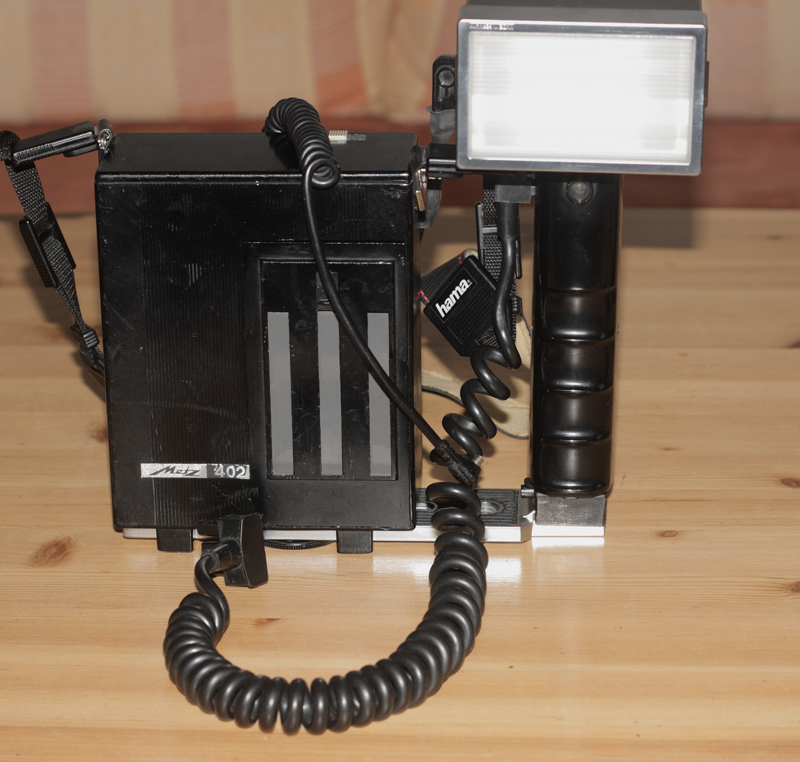
You can connect two flashes on one generator. The guide number = 56 on ISO 100. Each flash can flash independent from the other and also
regulate with small slide switches for ISO and f-stopp, or can be used in
max. Mode.
You can have some different filters in red, green, blue and neutral.
A diffraction screen is also available for this unit. So the flash can also use for Medium Format.
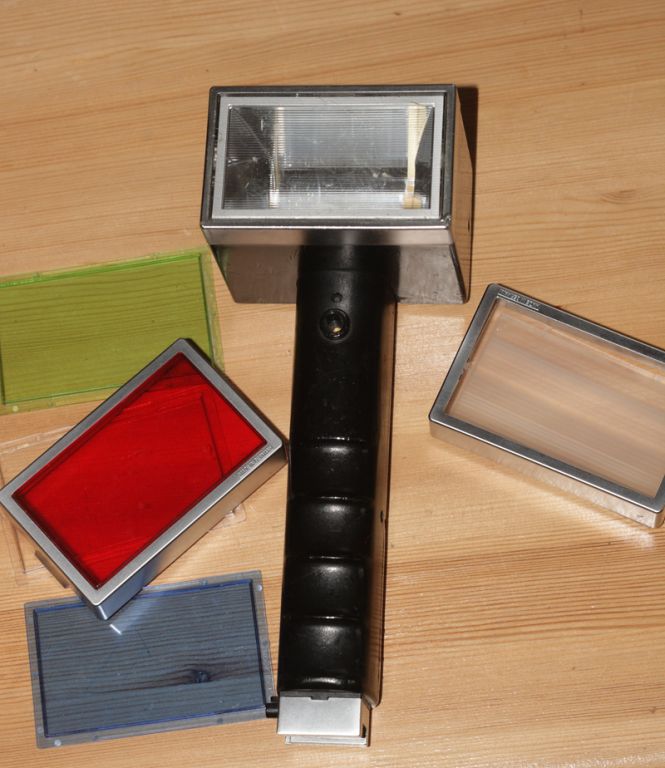
Here is my complete set of 5 Flashes and 3 Generators..
(and an additional Metz 45 CT1 for some other situations)
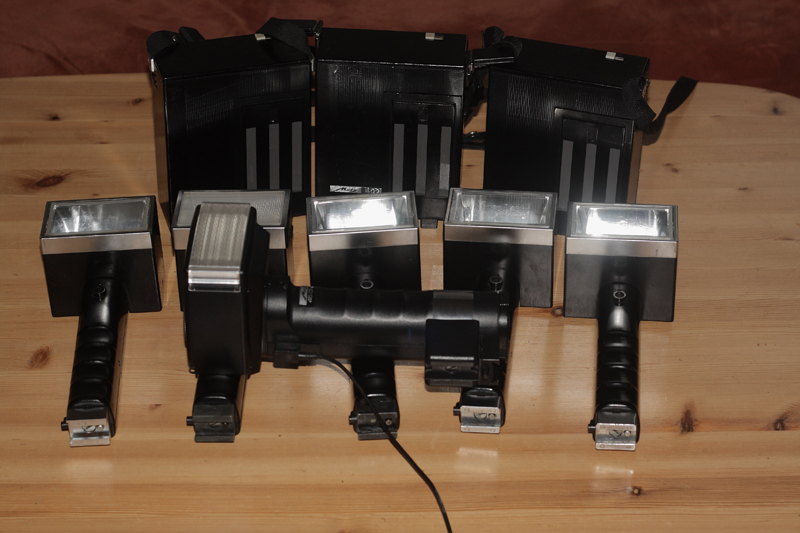
One further important feature, the mechanical interface between the flash and the camera, the rail, has some screw threads, which you can use for extend more than the normal way of using that. Here is a pic, that says more than thousand words...
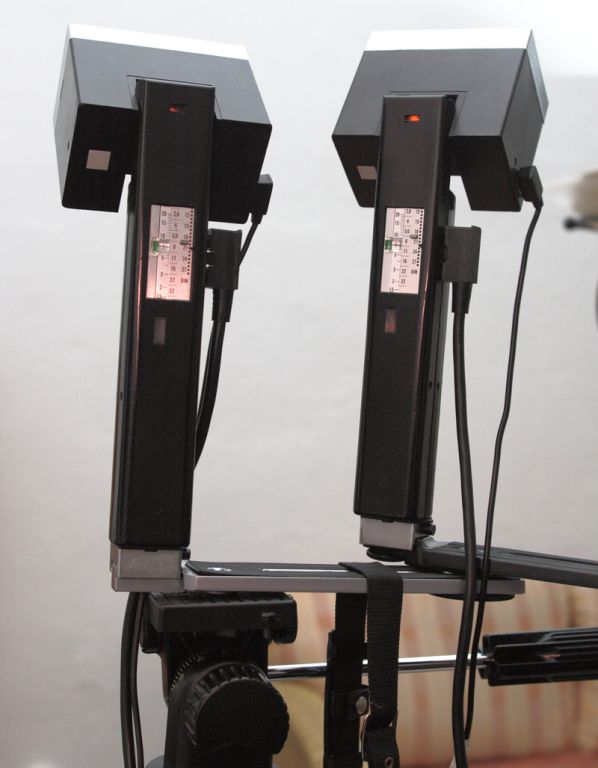
On one Tripod you can realize different positions for the flashes.. as this
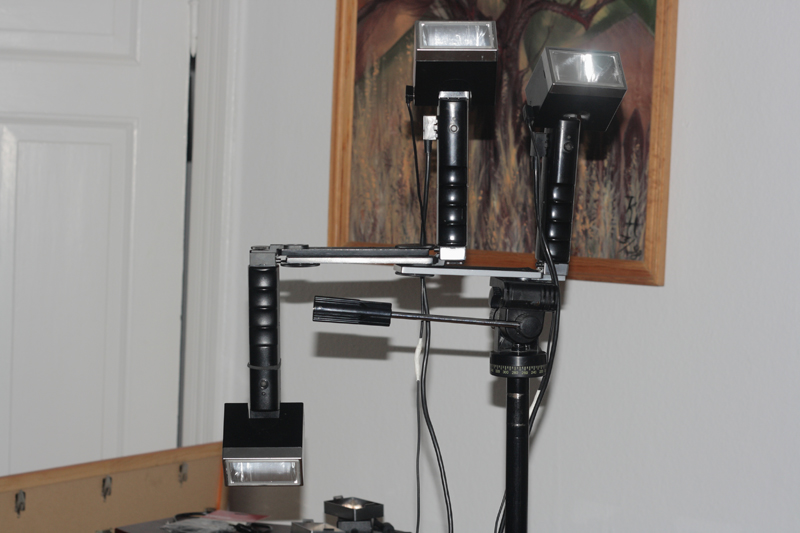
You can also reverse the flash direction etc..
What i want to say, this units are very flexible..
To control the 2 of the 3 Generators i decided to buy 2 cheap
16 - channnel taiwanese radio transmitter and make my own realisation of connecting the transmitter to the flash. I did buy 2 of them and converted the normal x-contact jacks to chinch. This gives the ability to connect more than one flash to one receiver.
Here is a picture of the solution.
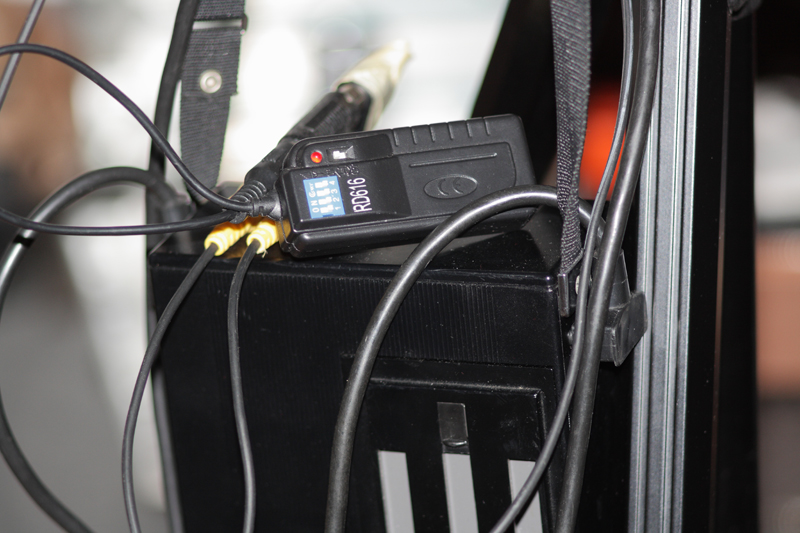
I also splitted the power chords and converted them to XLR jacks to make them longer with 3-wire microfon - cables..
Hope you can imagine, how i realized this mini studio..
So, how does it works?
Ok lets have a look.. first of all, there was no model in the house, so i have to manage all by myself.. 
My flat has a ceilling heigth of about 4 meters.. so it was necessary to use two flashes for indirect "bouncing" light. LZ 112 against the ceiiling...

I also did use a simple white umbrella as a refector in this way..
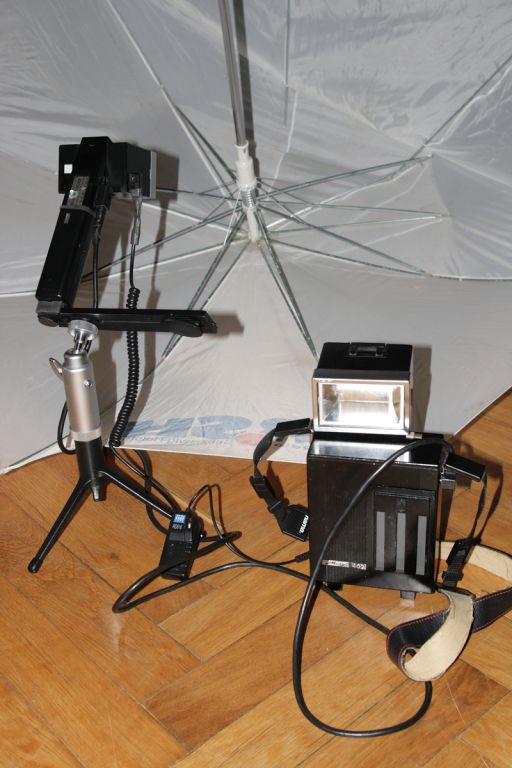
My small Leica travel and desk - tripod did a good job for holding the flash... 
For finding the correct light balance between the bounce and the reflecting part i did use my my ceilling light stand.. with an old hat from the summer days, to find out, how the shadow to light ratio must be..
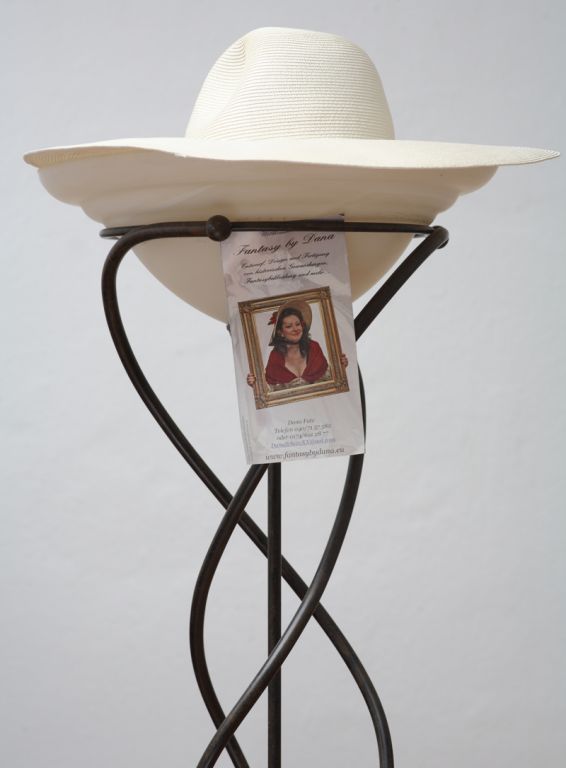
Isnt it a lovely model  
After some shots i marked the position and replace the beuatiful lamp with myself.. ugly 

This solution is a small but nice and easy to transport set for small jobs in the family, neighborhood and can also help in much situations to make things easier in daylight situations. It costs less then one System Flash from Canon and is much more flexible.
Cheers
Henry
_________________
some light-painting lens stuff.. 
... and an EOS 5D MKII
www.digicamclub.de
Last edited by hinnerker on Wed Nov 04, 2009 7:21 pm; edited 1 time in total |
|
| Back to top |
|
 |
hinnerker


Joined: 17 Aug 2009
Posts: 929
Location: Germany near Kiel
Expire: 2015-08-09
|
 Posted: Wed Nov 04, 2009 6:57 pm Post subject: Posted: Wed Nov 04, 2009 6:57 pm Post subject: |
 |
|
hinnerker wrote:
In addition to the initial post i have to say, that the trigger voltage of the Metz 402 Units are about 217 Volts..
Here my experiences with different Canon cams:
EOS 350D... no problems up to 250 Volts, if you can make sure, that the
X-Contact of the flash not comes in contact with the 4 small contacts which manage the interaction between cam and Canon System Flashes. This contacts are the "Achilles heel"..
so i did use the X Shoe only with isolating films over the 4 contacts and with a screwable hotshoe... it works fine all the time.
Canon 400D.... the same..
Canon 5D.. the same, in addition to that, the EOS 5D did have a cable contact which is also able to handle the old trigger Voltages. Its a X-contact on the left side of the cam, they named it PC-contact.. it mean to remember. So the 5D is uncritically for the old flashes.
Cheers
Henry
_________________
some light-painting lens stuff.. 
... and an EOS 5D MKII
www.digicamclub.de |
|
| Back to top |
|
 |
|
|
|
You cannot post new topics in this forum
You cannot reply to topics in this forum
You cannot edit your posts in this forum
You cannot delete your posts in this forum
You cannot vote in polls in this forum
|
